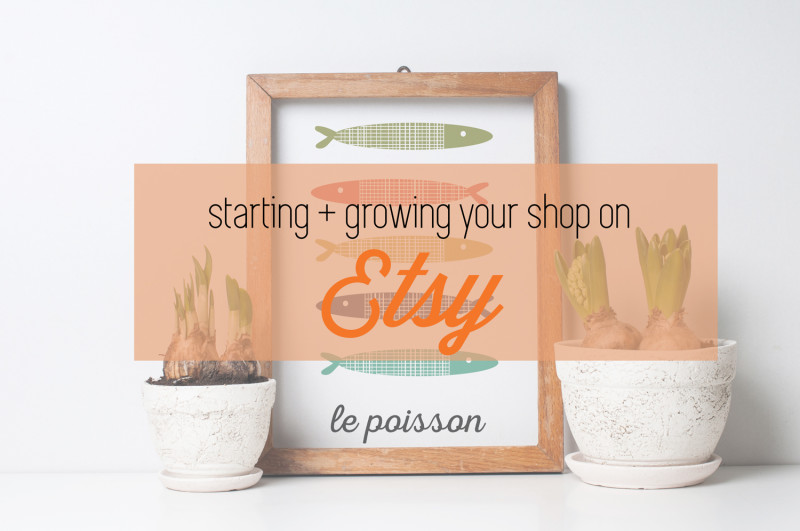Starting and Growing Your Etsy Shop

I’ve been selling in some form or another on Etsy since 2008. I started out making jewelry and eventually transitioned to art prints, paper goods, and offering some design services. When I first started selling, many people had no idea what Etsy was. It took years before Etsy became an almost household name for quirky and cool handmade and vintage goods. I started rededicating myself to selling in earnest again after a brief hiatus where I was finishing my degree and focusing on building my freelance business. While I’m still focused on freelance I love having additional revenue coming in as well as a place where I have an excuse to create things I may not have the chance to in my daily work. Since I’m getting back to building up my Etsy shop I thought now would be a good time to share some things I’ve learned over the years.
- don’t start a shop before you have a good deal of stock. I see so many new stores open that only have two or three things to sell. Think about going to a retail space that only has a handful of options. You won’t stay long even if the items are great. You want customers to stay awhile and to do that you need a couple pages of items for them to browse through.
- familiarize yourself with Etsy’s do’s and don’ts. Getting your shop up and running only to have it shut down by Etsy is not fun. I’ve seen many shops gain sales and success only to violate Etsy’s rules and be shut down, all their hard work lost. Read through the rules and make sure you double check that every item you list is in line with the policies. Trademark infringement is probably the most cited reason for shops getting penalized. A good rule of thumb for trademark: if it’s not your intellectual property and your using it to sell items, your probably violating the rules. I know there a lot of shops out there selling Harry Potter, Twilight, and Star Wars stuff but it doesn’t mean you have to follow the crowd. Some shops DO have permission to sell those items but the majority do not. Also be mindful of using tags or titles with trademark terms such as “onsie,” for example, which is owned by Gerber. If you’re unsure, do some research. If your still unsure, it’s best to move on.
- learn best practices for tags and titles. Etsy has it’s own rules for how your items show up in search. Make sure you understand the best practices and apply them consistently. One important rule of thumb is to make your tags and titles descriptive. For example: if your selling an amethyst necklace on a leather cord don’t name it something generic like “the amazing necklace.” Instead a good title would be, “purple amethyst mineral quartz necklace on leather cord.” All those words are ones that a buyer might put into search when looking for an item like that. The more specific the better. Your tags should follow the same rules. Make tags specific and that reflect what a customer might search for. You only have 20 characters per search term, so keep that in mind too. Also, a big no no is to have tags and titles that don’t actually apply to your item in an attempt to show up in different searches. As a buyer there is nothing more annoying than doing a search for “toddler leggings” and getting some results for jewelry or something else that has nothing to do with my search. Don’t do it. It doesn’t work anyway.
- good photos sell your items. Let’s use the retail analogy again. Imagine walking into a shop where displays were haphazard, everything was too dark, and you could barely figure out what the heck the shop was selling. You probably wouldn’t stay let alone buy anything. That’s how buyers feel when they go to an online shop with bad photos. Blurry, too dark, blow out, or photos with too much going on are not going to sell your product effectively. I know this particular nugget has been shared a million times but it bares repeating. Get yourself a decent camera, hire or trade services with a photographer, or use your smart phone and an editing app or software. Simple backgrounds are best though neatly styled photos are also very effective. It is 100% better to wait to open a shop until you get quality pictures than rush to put up bad photos. You want your first impression to be good. Which brings me to the next point…
- first impressions matter. This is tricky because on a site like Etsy, you’re getting new buyers all the time. This means that it’s important that from the first day you open shop and forever moving forward, your shop communicates your brand. Yes the brand word again. Your shop should be professional, well maintained, regularly updated, and reflective of you and your brand. Every day your open, new buyers are stopping by. Make sure your shop looks good. Always.
- establish your brand. It’s not good enough anymore to just have cool items to sell. You need to have a cohesive brand to complement your work. Invest in a good logo for starters. That logo will be used for your shop banner as well as for your avatar if you don’t want to use a photo of yourself or your work. Make sure that you use your branding identity across all your social media as well. If you set up a Facebook page for your shop, use your logo and photos showing your work. Same with a Twitter page. If you’re unsure how to brand your page I offer those services here. You can also find sellers on Etsy that will brand your social media as well as create a logo for your business. Beware though of too good to be true prices on that kind of work. It’s better to invest more up front on your branding than realize later that it’s too generic/low quality/ect.
- quality over quantity. I know I just said that having a lot of items in your shop is important, but all of those items should always be your best work. Never add items that you feel unsure about. There is nothing wrong with experimenting and offering something different. There is a huge difference between different and low quality. If you always use sterling silver for your jewelry but decide to offer some lower cost items in a base metal, no problem. However, if you decide to use the cheapest material possible that will fall apart after the first use, be prepared for a lot of returns and a lot of unhappy customers. It’s better to sell high quality items and have less in your shop, then try to fill it with the cheapest stuff around.
- let buyers get to know you. Etsy has a great option for sellers where they can write a bio and share photos of their work space, process, ect. Use it! You can also add your social media links as well including Pinterest and Facebook page. Let buyers get to know the person behind the shop. Make sure your bio, shop intro, and policies are filled out and reflect you and your shop. Here’s my shop bio to give you an idea of what to include.
- don’t give up. Unless you happen to already have an established shop/social media presence elsewhere, don’t be discouraged if you don’t sell much right away. It takes time to get the word out about your shop and even more time to get buyers to pay for your stuff. You need to differentiate yourself and your product from the millions of sellers on Etsy. It can be slow going those first few months and it’s important that you keep moving forward. Promote yourself off of Etsy via social media, through word of mouth, and by having great products. If you build it right, they will come. Eventually.
Have any tips you want to add? Write a comment and share your knowledge!






